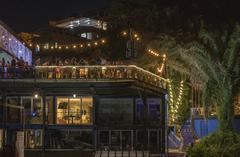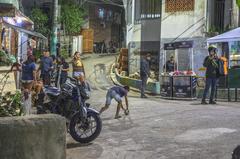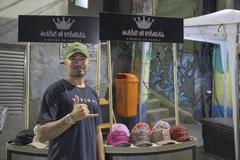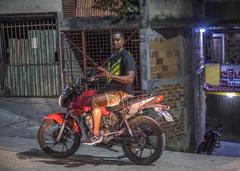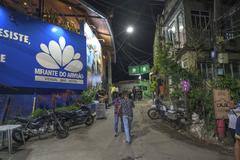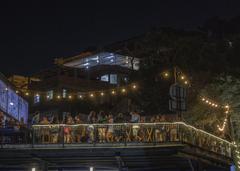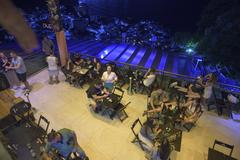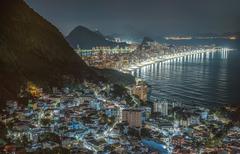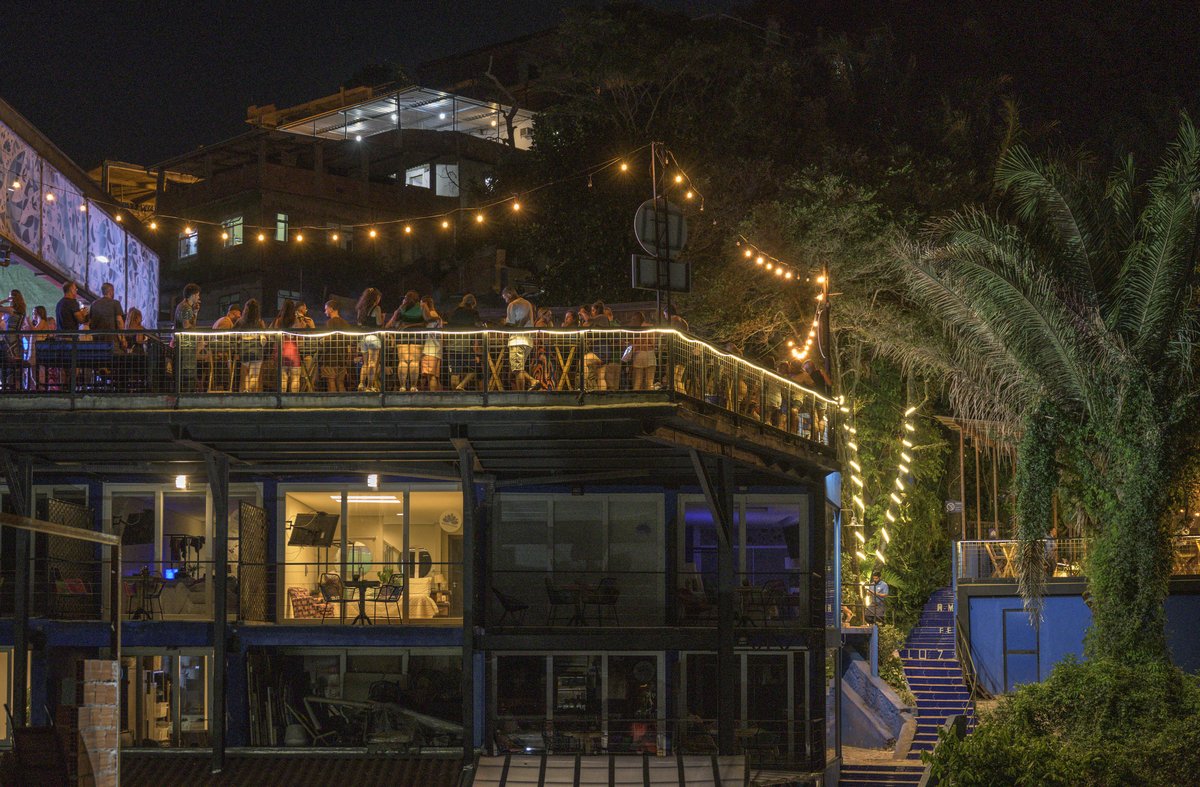
Vidigal, Rio de Janeiro: Visiting Hours, Tickets, and Historical Sites Guide
Date: 14/06/2025
Introduction to Vidigal, Rio de Janeiro
Nestled between the affluent districts of Leblon and São Conrado, Vidigal is one of Rio de Janeiro’s most iconic and culturally vibrant favelas. With origins dating back to the early 20th century, Vidigal was founded by freed slaves and rural migrants seeking opportunity in the city (Brown University Library; Wikipedia). Today, it is celebrated for its breathtaking views from Morro Dois Irmãos, colorful street art, and dynamic community life.
Visitors to Vidigal experience more than stunning landscapes—they are welcomed into a neighborhood defined by resilience, creativity, and a strong sense of identity. The favela’s transformation through grassroots initiatives and pacification has fostered a thriving cultural scene, responsible tourism, and sustainable community-led development (A Cruising Couple; Favela Inc). This guide provides essential information on Vidigal’s history, practical visitor details, safety, main attractions, and ways to engage with the community respectfully.
Table of Contents
- Introduction
- Historical Background and Community Development
- Practical Visitor Information
- Main Attractions in Vidigal
- Community-Led Initiatives and Responsible Tourism
- Safety, Accessibility, and Travel Tips
- Frequently Asked Questions (FAQ)
- Conclusion
- Sources and Further Reading
Historical Background and Community Development
Origins and Evolution
Vidigal’s roots can be traced to the late 19th and early 20th centuries, when freed slaves and rural migrants, excluded from formal housing, built homes on the steep slopes of Morro Dois Irmãos (Brown University Library). Despite attempts at removal and marginalization, Vidigal’s residents established strong community organizations and persevered, creating a neighborhood with a distinct cultural identity (A Cruising Couple).
Community Organization
Residents’ associations were formed to advocate for basic services and infrastructure. Over time, Vidigal benefited from urban integration programs and developed a lively local economy, with small businesses, eateries, and social projects underpinning community life.
Cultural Identity and Social Resilience
Vidigal’s community resisted forced removals and city-led gentrification, preserving its Afro-Brazilian heritage through music, dance, and visual arts. The favela’s identity is reflected in its samba schools, funk carioca rhythms, and colorful murals, attracting visitors seeking authentic cultural experiences.
Pacification and Change
In 2011, Vidigal underwent pacification with the introduction of Pacifying Police Units (UPP), improving public safety and encouraging tourism (A Cruising Couple). This shift brought new investment and social innovation, but also challenges related to gentrification and rising costs.
Practical Visitor Information
Visiting Hours and Tickets
- General Access: Vidigal is an open community with no entry fee or formal visiting hours; it can be visited at any time.
- Best Times to Visit: For safety and optimal views, visit between 8:00 AM and 6:00 PM.
- Guided Tours: Highly recommended for context and safety. Tours typically run between 9:00 AM and 6:00 PM. Book in advance through reputable operators or community organizations (Next Stop Brazil).
How to Get There
- By Taxi or Ride-share: From central Rio, taxis and ride-sharing apps (Uber) are the safest and easiest way to reach Vidigal.
- By Public Transport: Buses run along Avenida Niemeyer, but avoid buses after dark.
- On Foot: Walking from Leblon or São Conrado is possible, but be prepared for steep climbs and narrow alleys.
Accessibility
Due to Vidigal’s hillside terrain and staircases, access can be challenging for those with mobility limitations. The Morro Dois Irmãos hike requires moderate fitness.
Costs and Payments
- Affordability: Meals and services are generally more affordable than in tourist hotspots.
- Payments: Cash is preferred; some businesses accept cards, but ATMs are limited—bring sufficient cash.
Main Attractions in Vidigal
Morro Dois Irmãos (Two Brothers Hill) Hike
A must-do in Vidigal, this moderate hike (about 1.5 km each way) winds through Atlantic rainforest to a summit with panoramic views of Rio’s beaches and skyline (Dois Irmãos Trail Guide). Guided hikes are recommended for safety and local insight.
Favela Art and Street Murals
Vidigal’s walls are canvases for vibrant street art, reflecting local history, pride, and social commentary. Guided art tours reveal the stories behind the murals (Favela Art Tours).
Beaches and Viewpoints
Praia do Vidigal is a quiet local beach accessible from the favela, while several “mirantes” (viewpoints) offer stunning photo opportunities, especially at sunrise and sunset.
Nightlife and Dining
Notable venues include:
- Bar da Laje: Rooftop terrace, live samba, and city views (Bar da Laje Instagram).
- Hostel Mirante do Arvrão: Rooftop events and panoramic scenery (Mirante do Arvrão).
- Alto Vidigal Brasil: Open-air parties and cultural events (Alto Vidigal Brasil).
Community Projects and Social Enterprises
- Favela Experience: Immersive tours and homestays (Favela Experience).
- Projeto Vidigal Capoeira: Capoeira classes for visitors and locals.
Cultural Events and Festivals
Vidigal hosts music nights, festivals, and religious celebrations throughout the year, offering authentic engagement with community traditions.
Community-Led Initiatives and Responsible Tourism
Social Innovation and Education
- Batucavidi: Percussion program fostering Afro-Brazilian culture (Favela Inc).
- SER Alzira de Aleluia: Education, vocational training, and social support (SER Alzira de Aleluia).
- Favela Inc: Incubator for sustainable projects and entrepreneurship (Favela Inc).
Environmental Efforts
Solar energy installations and green infrastructure projects improve sustainability and resilience (RioOnWatch).
Responsible Tourism
Support community-run guesthouses, restaurants, and tours. Avoid “poverty tourism”—seek meaningful cultural exchange and respect local customs.
Safety, Accessibility, and Travel Tips
Safety Profile
Vidigal has seen significant improvements in safety, but visitors should remain vigilant:
- Daytime Visits: Best undertaken between 8:00 AM and 6:00 PM.
- Guided Tours: Enhance safety and provide valuable context.
- Dress Modestly: Avoid flashy items and keep valuables secure.
- Transportation: Use taxis or ride-shares, especially after dark.
- Photography: Always ask permission before photographing residents.
Health and Practicalities
- Terrain: Wear sturdy footwear for hills and steps.
- Water: Drink bottled water.
- Language: Basic Portuguese is helpful; English is spoken by some guides.
Emergency Contacts
- Police: 190
- Ambulance: 192
- Fire: 193
- Residents Association: Contact for local guidance (RioOnWatch).
Frequently Asked Questions (FAQ)
Q: Is there an entrance fee or ticket required?
A: No, Vidigal is open to all. Guided tours and cultural events may require a ticket.
Q: What are the best hours to visit?
A: Daytime, especially between 8:00 AM and 6:00 PM.
Q: Is Vidigal safe for tourists?
A: Yes, especially with local guides and during daylight hours. Avoid wandering alone at night.
Q: How do I get to Vidigal?
A: Take a taxi, ride-share, or guided tour. Public buses operate along Avenida Niemeyer.
Q: Are there accommodation options inside Vidigal?
A: Yes, several guesthouses, hostels, and boutique hotels are available.
Q: Can I volunteer in Vidigal?
A: Yes, NGOs and community organizations welcome volunteers for various educational and cultural programs.
Conclusion
Vidigal is a testament to community resilience, cultural wealth, and the transformative power of grassroots innovation in Rio de Janeiro. From hiking trails and artistic murals to immersive cultural projects, Vidigal invites respectful visitors to experience its unique heritage and contribute to sustainable development.
For up-to-date maps, tour bookings, and community event information, download the Audiala app and follow us on social media. By engaging with Vidigal’s people and projects, you help foster responsible tourism and authentic cultural exchange.
Sources and Further Reading
- Favelas in Rio de Janeiro: Past and Present, Brown University Library
- What It’s Like to Stay in a Pacified Favela – The Highlights of Vidigal, A Cruising Couple
- Vidigal, Rio de Janeiro, Wikipedia
- Favela Tours in Brazil – How to Visit Favelas with a Local Guide, Next Stop Brazil
- 9 Best Things to Do in Vidigal, Rio de Janeiro, Tourist Maker
- Top Tips for Exploring a Favela in Rio de Janeiro, Strawberry Tours
- Favela Inc
- RioOnWatch Articles
